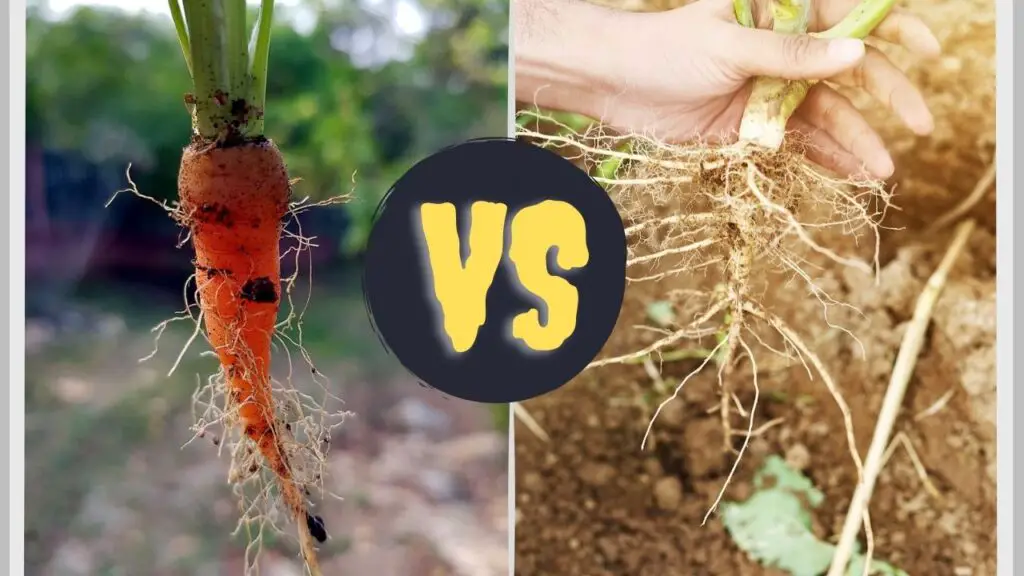We use affiliate links to run our site. When you buy through links on our site, we may earn an affiliate commission, without any added cost to you. Learn more
There are two kinds of plant roots: taproots and fibrous roots. While both kinds provide a source of stability and help the species grow, the two root systems are fundamentally different. Let’s compare taproot vs fibrous root, so we can can understand more about the plant root systems.
In this post we will break down the anatomy of these two root systems to show you the basic differences between the two.
What is Taproot:
A taproot in a plant refers to the primary root in most plants and it branches out to secondary and tertiary roots. Taproots are the thickest root of a plant and usually appear immediately after germination.
It runs deep into the soil, and collects water and nutrients for the plant.
Shapes of Taproots:
Taproots are mostly found in dicotyledons and can be of many shapes. It can be either
- Conical
- Fusiform, or
- Napiform.
Conical taproots are widest at the top and tapering steadily towards the bottom. These types of taproots are found in Carrots.
Fusiform taproots are a bit different. They are widest in the middle and not at the top. They start tapering towards the top and the bottom. Fusiform taproots are common in plants like Radish.
Another common taproot root is the Napiform taproots. The uniqueness of this shape is that it is very wide at the top and tapers suddenly into a tail at the bottom. Napiform taproots are a characteristic feature of plants like Turnips.
Examples of Taproots:
Some of the most common plants that have taproots systems are
What is Fibrous Roots:
The fibrous roots originate in the stem. They usually form a cluster of thin and moderately branching roots without any primary root.
The fibrous root system is a skeleton-like structure under the plant. The roots look like fine hairs that spread outward, rather than just sticking straight down into the earth.
Most of the fibrous roots are generally in the 50m of the soil. Fibrous roots are characteristic features of monocotyledon plants.
Examples of Fibrous Roots:
Some of the plants with fibrous root systems are:
- Grasses
- Wheat
- Rice
- Corn
- Rosemary
- Coconut, etc.
Taproot Vs Fibrous Root:

So lets summerise. Here are the basic differences between taproots and fibrous roots:
| Taproots | Fibrous Roots |
| Taproots are developed from the primary root. | Fibrous roots develop from the stem of the plant. |
| Taproot system is mostly found in dicotyledon plants. | Fibrous root system is mostly found in monocotyledon plants. |
| Taproots are much thicker than fibrous roots. | They are very thin and hair-like. |
| A plant can only have one taproot. | The number of fibrous roots are numerous. |
| Taproots are always remain underground. | Fibrous roots can be underground as well as aerial. |
| In the tap root system, the primary root differentiates into secondary and tertiary roots. | There is no differentiation in the fibrous root system. |
| Taproots are usually longer in size . | Fibrous roots are usually very short. |
| Taproots can store foods. | Cannot store food. |
| Taproot grows vertically downwards. | Fibrous roots grows mostly horizontally. |
| The Taproot system anchors the plant more firmly than the fibrous root. | Anchorage is quite feeble in fibrous root system. |
| Some examples of plants that have a tap root system are carrot, mustard, radish, turnip, beetroot, parsley, coriander, etc. | Some examples of plants that have a fibrous root system are Grasses, Wheat, Rice, Corn, Rosemary, Coconut, etc. |
Taproots and fibrous roots systems are very different. Hopefully, you now know the difference between the two. Check back soon for more interesting topics.
Amazon and the Amazon logo are trademarks of Amazon.com, Inc, or its affiliates.

Hi there! My name is Prasenjit and I’m an avid gardener and someone who has grown a passion for growing plants. From my hands-on experience, I have learned what works and what doesn’t. Here I share everything I have learned.
